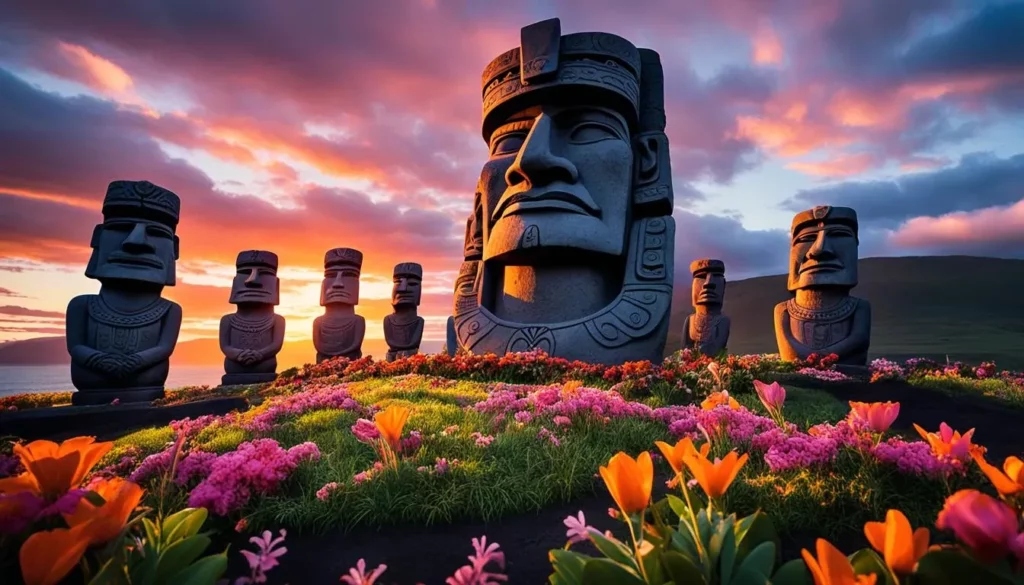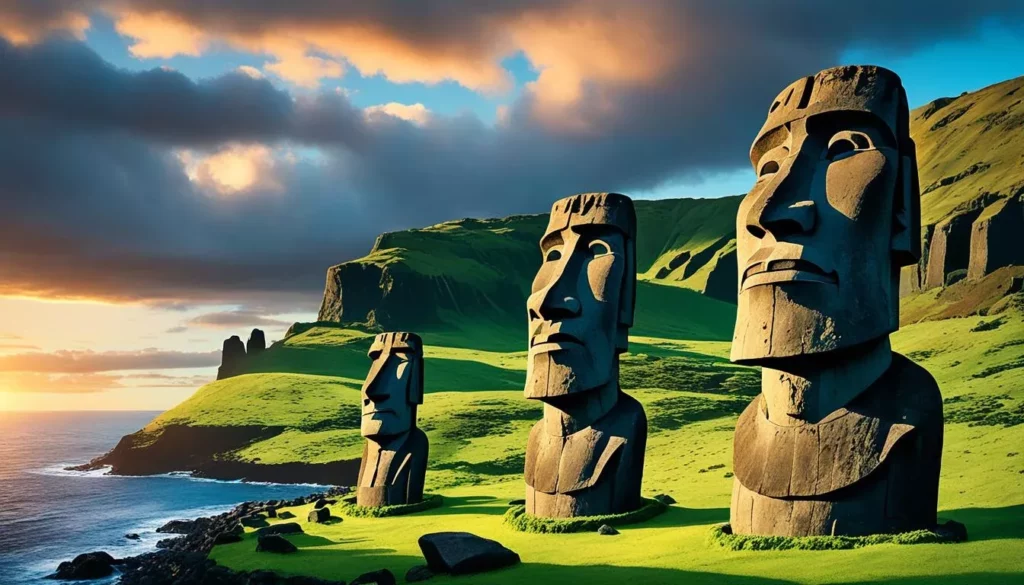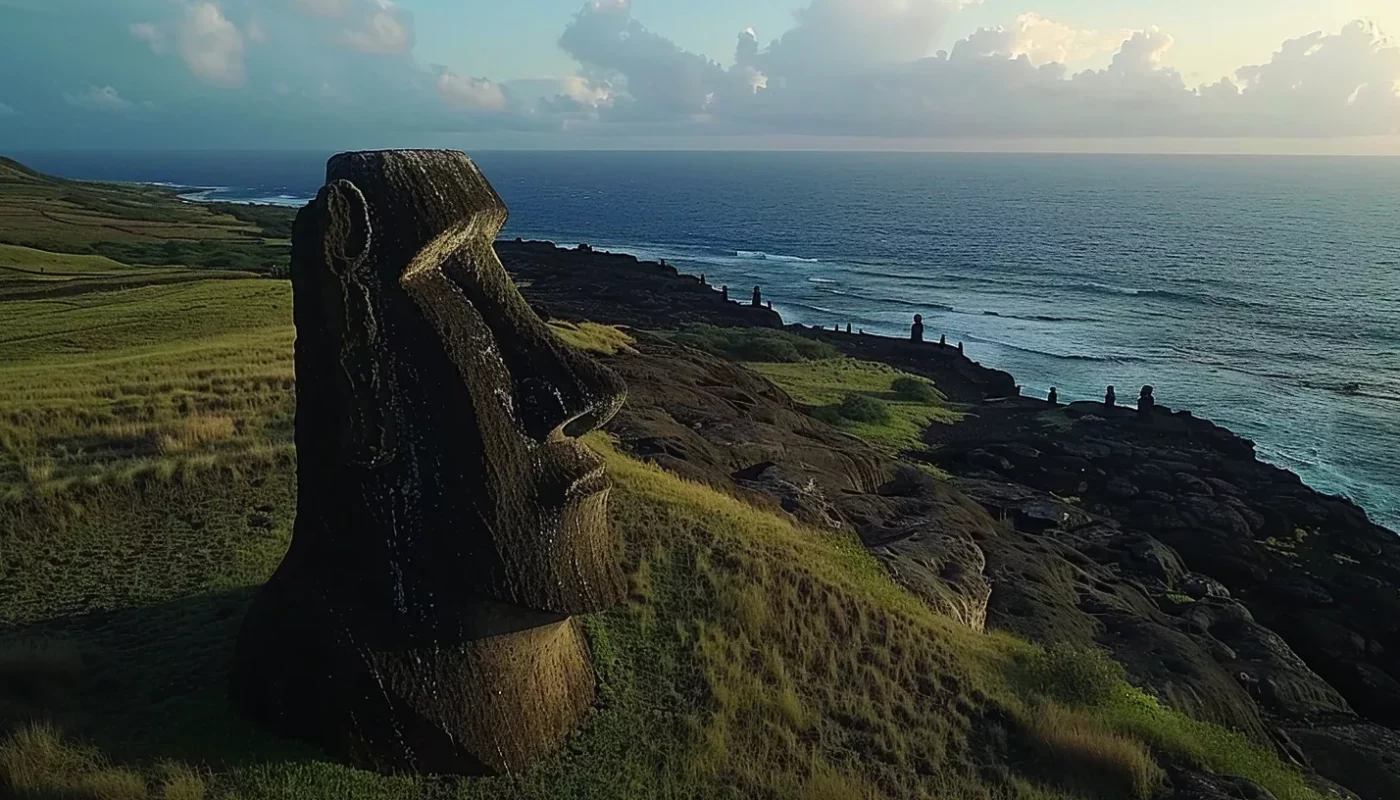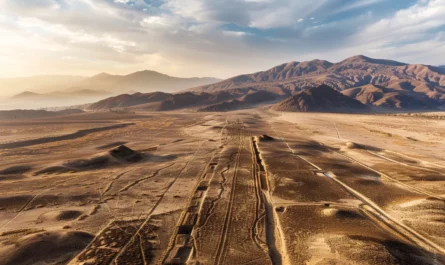Rapa Nui, or Easter Island, is an incredibly remote place. It’s situated 1,289 miles from Pitcairn Island and 2,182 miles from Chile. This isolation has created a distinct and fascinating culture, with deep mysteries surrounding its history.
The island is famous for its nearly one-thousand Moai statues. These massive figures made from volcanic rock have captivated many. They show the creativity and beliefs of the Rapa Nui people, challenging earlier negative assumptions about them.
The stories told by the Indigenous Rapa Nui highlight their ancestors’ clever techniques, like how they moved the Moai without harming the environment. These tales resurfaced during the 300th anniversary of the island’s first encounter with European explorers. They were further brought to life by filmmaker Sergio Mata’u Rapu.
Studying Rapa Nui history and the mystery of the Moai is fascinating. Yet, it’s also key to focus on protecting these artifacts and the island’s heritage. This ensures that the marvels of this unique Pacific culture can be appreciated by others in the future.
The Enigmatic Moai Statues of Rapa Nui
The Moai statues of Rapa Nui are a key part of the island’s culture. Made from volcanic rock, they are not just sculptures. They stand for the island’s ancestors and are central to Polynesian tradition.
Origins and Significance
The Moai are deeply tied to Rapa Nui’s identity. They honor the ancestors and their lasting impact. These statues show the islanders’ respect for their past. They connect the living to the spiritual world.
Their solemn faces show a watchful quiet. This reflects the people’s regard for their history.
Construction Methods
The Moai were made from volcanic rock by skilled artisans. They show incredible engineering and artistry. Quarrying, carving, and moving these giant figures was a monumental task.
Local craftsmen used precise techniques and teamwork. This highlights their cleverness and cooperation.
Debunking the Alien Theories
Some say aliens made the Moai, but that’s not true. They are the work of Rapa Nui’s skilled ancestors. Signs of tools and wear prove they were made by humans. Experts like Sergio Mata’u Rapu argue against alien theories. They keep the culture’s true story alive.
First European Contact and the Name “Easter Island”
The Easter Island discovery on Easter Sunday, 1722, was a turning point in history. It led to the island being named. This day was significant for European exploration in the Pacific. It involved well-known explorers of the 18th century. Their views would later shape stories about Rapa Nui.
Discovery in 1722
On Easter Sunday of that year, Dutch explorer Jacob Roggeveen arrived at Rapa Nui. It marked the first Rapa Nui first contact with Europeans for the island’s people. Roggeveen’s visit showed Europe’s drive to explore. It started a chain of events that would deeply affect Rapa Nui’s destiny.
Impressions of Early Explorers
Among these 18th-century explorers, one was French navigator Jean-François de Galaup, comte de La Pérouse. His 1786 journey offered crucial insights. He described the Easter Island discovery as finding a declining society. La Pérouse and his team were struck by the Moai statues. They wondered about their origins and the people who made them.
These first views helped form a lasting story of Rapa Nui’s history. They shaped how Europeans saw Rapa Nui and directed future studies. This Rapa Nui first contact sparked a lot of research and discussion. It explored the island’s history, culture, and people within the scope of European exploration.
“La Pérouse and his contemporaries offered a foundational yet flawed interpretation of the island’s history, underestimating the nuanced and resilient nature of Rapa Nui’s culture.”
While the initial stories talked about decline, later studies worked to correct these views. They underline the importance of protecting Rapa Nui’s incredible heritage. These efforts aim at preservation and conservation.
Indigenous People and Their Oral Histories
The Indigenous people of Rapa Nui have kept a lot of knowledge alive through their stories. Their oral traditions reveal much about the island’s history, correcting many wrong ideas. By holding onto their ancestral stories, they show how wise and clever their ancestors were.
At these traditions’ core are stories about Rapa Nui’s first settlers, including the legendary first king, Hotu Matu’a. These stories tell about the big trips across the sea. They were led by dreams and signs, not just chance. This shows that the first people to live there knew a lot about how to navigate the sea.
Stories of Ancestral Knowledge
Benedicto Tuki, like some other descendants, often tells legends that highlight the value of keeping and sharing indigenous knowledge. These tales are key to the cultural identity of Rapa Nui people. They remind everyone of the strength and deep roots the people have in their Polynesian background. The stories help honor and remember what their ancestors did.
The Rediscovery of Ancient Techniques
A key part of Rapa Nui oral traditions is finding old techniques that were almost forgotten. For example, modern scholars have learned about farming and stone carving from these stories. These skills were shared by word of mouth, showing how inventive and eco-friendly the ancient Rapa Nui people were.
Preserving these traditions is also very important. Conservation efforts aim to keep these stories and methods from being lost. By recording these traditions, we’re not just saving history. We’re teaching young people to appreciate the great worth of their Polynesian roots.
Environmental Challenges and Theories of Collapse
Rapa Nui faces key environmental challenges which help us understand its history and culture shifts. The theory of environmental collapse is hotly debated. It often cites deforestation and poor resource management. Collapse by Jared Diamond states Rapa Nui’s deforestation happened because islanders cut trees to move the Moai statues. This may have caused environmental collapse and cut the population down.
Deforestation and Resource Management
Many believe Rapa Nui saw major deforestation, damaging its ecosystem and way of life. Diamond says the locals overused natural resources, leading to collapse. Yet, modern studies and locals like Gina Pakarati offer a different view. They say their ancestors used island resources wisely, questioning the deforestation story.
Debates on Population and Civilizational Decline
Rapa Nui’s population decline debate is complex, with various theories. Some blame environmental issues Diamond highlighted. Others look at European diseases and slave raids that hit the native people hard. Rapanui oral traditions argue against an environmental doom. They show a society that was clever in adapting to their setting.
Today’s conservation is vital for Rapa Nui’s delicate ecosystem and cultural heritage. Actions include replanting trees and promoting tourism that’s mindful of the environment. With UNESCO’s recognition as a World Heritage site, these efforts gain worldwide attention and support. They help safeguard Rapa Nui’s environment and its cultural importance.
The Archaeological Significance of Rano Raraku Quarry
Rano Raraku Quarry is nestled into the volcanic slopes of Rapa Nui. It’s known as the birthplace of the island’s Moai statues. Here, visitors can see ancient carving techniques used by Rapa Nui’s artisans.
Unfinished Moai and Carving Techniques
Numerous unfinished Moai at Rano Raraku Quarry form an open-air museum. They show how the Moai were made from the quarry’s rock using stone tools. The statues reflect a deep understanding of geometry and craftsmanship.
The Mystery of Transporting Giant Statues
The method of moving the giant Moai remains a mystery. Theories range from using ropes and sledges to “walking” the statues upright. This enigma fuels archaeological research.
Preserving the quarry’s artifacts is essential. Conservation efforts help protect the exposed Moai from the elements. This work ensures they remain intact for future generations.
The Role of Rituals and Religion in Rapa Nui Culture
Rapa Nui’s culture is deeply connected to rituals and religion. These traditions affect many parts of life on the island. The famous Moai statues are not just art and architecture. They are key to the island’s spiritual world. They represent the mana of ancestors, making them vital in Polynesian spiritual customs.
The Moai play an essential role not just as historical artifacts but as living embodiments of ancestral power, weaving the past and present of Rapa Nui together.
Religious events with the Moai are key for keeping the community’s spiritual ties. These Rapa Nui rituals have offerings, chants, and processions. They strengthen the bond between the islanders, their ancestors, and the sacred land.

- Annual Celebrations: Major religious events happen yearly. They celebrate key moments and ask for blessings for the community.
- Ancestor Worship: The Moai are central in ceremonies that honor the ancestors. This shows the deep belief in their lasting impact.
- Polynesian Spiritual Practices: These unique rituals showcase their Polynesian roots. They connect the island to larger Pacific spiritual traditions.
It’s very important to keep these practices and the Moai safe. Efforts to preserve them are ongoing. This work helps protect the statues from harm. It ensures future Rapa Nui generations can keep up their religious ceremonies. They can also continue the Polynesian spiritual practices that shape their culture.
Navigation and Settlement: How the Ancestors Arrived
Polynesian navigators were the first to settle on Rapa Nui. They arrived around AD 400, as estimated by linguists. Archaeologists believe they came between AD 700 and 800. These early settlers navigated the vast Pacific using stars, ocean currents, and cosmic events.
Pioneering Navigation Techniques
Polynesian navigation was revolutionary. By 5500 BC, people in Melanesia were voyaging and trading obsidian. By AD 300, they had reached Tahiti and the Marquesas Islands. They were experts at reading the sky and the sea, which led them to Rapa Nui.
Theories on Polynesian Voyages
Many theories exist about how Polynesians voyaged. Scholars debate the routes but agree on their exploration spirit. DNA from Easter Island skeletons confirmed their Polynesian roots in 1994. Their voyages peaked Rapa Nui’s population at 9,000 by 1550, showing their tight-knit communities.
These navigators mastered the sea. They used stars, ocean swells, and bird flights to find their way. This shows their navigation was precise, allowing them to settle on Rapa Nui.
Yet, they faced environmental challenges like deforestation. Still, their legacy, including Moai statues, remains a testament to their achievements. These statues, carved between 1400 and 1600, highlight their sustainable practices.
| Key Events | Date |
|---|---|
| First Inhabitants Arrive | AD 400 |
| Archaeological Settlement Evidence | AD 700-800 |
| Obsidian Trade in Melanesia | 5500 BC |
| Tahiti and Marquesas Reached | AD 300 |
| Rapa Nui Population Peak | 1550 |
| DNA Evidence Found | 1994 |
Modern Interpretations and Popular Theories
Rapa Nui is famous for its nearly nine hundred moai statues. These giants have fueled a lot of theories. The moai are big, about thirteen feet tall and weigh twelve tons each, sparking debates about their creation.
Some people think aliens helped make the moai. This idea shows how much we love mysteries and big things. But, the real skill was in how the islanders moved these huge figures without today’s tools.
Experts believe the statues honor the Rapa Nui’s ancestors. They tell us about the island’s rich culture and beliefs, with each moai being spiritually important. Studies have debunked the idea that the islanders cut down forests to move the statues. Instead, they used clever techniques.
Distinguishing fact from fiction in Rapa Nui history is tricky. When Europeans arrived in 1722, about three thousand people lived there. By 1862, diseases and slave raids had greatly reduced the population.
The rongorongo script adds more mystery. It’s a unique Polynesian script found on wooden tablets. Sadly, all who could read it died from disease, leaving its meaning unknown.
Learn more about the past and future of Rapa Nui
Saving these symbols and statues is very important. Thanks to modern methods and UNESCO, we can keep the moai safe. Researchers are still figuring out the truth behind the many stories of Rapa Nui, aiming to preserve its legacy.
Efforts in Preservation and Conservation
Preserving Rapa Nui is crucial for protecting its unique legacy. Many strategies are in use to shield the Moai statues and nature.
Current Conservation Methods
Teams work on keeping the Moai statues safe from weather damage. They use protective layers and make the statues stronger. Local and global experts work together to keep the statues in good shape.
The Role of UNESCO in Protecting the Island
Being named a UNESCO World Heritage Site has helped Rapa Nui a lot. This status has brought more attention and money for important preservation work. UNESCO also pushes for eco-friendly tourism and sustainability.
Everyone is working together to keep the island’s culture and environment safe. This includes locals, global groups, and governments. They aim to preserve the Moai and the island’s beauty for the future.
Rapa Nui: A UNESCO World Heritage Site
The UNESCO recognition of Rapa Nui puts it in the global spotlight. It highlights the island’s vast cultural and archaeological treasures. This honor shows the world how important Rapa Nui’s heritage is.
The iconic Moai statues on the island tell stories of its past. These cultural landscapes show the strength and creativity of the Indigenous Rapa Nui people. They are rich in history and meaning.

Being named a World Heritage Site by UNESCO helps protect Rapa Nui’s treasures. This ensures future generations can also enjoy its stories and wonders. It brings together resources and experts to keep the island safe.
There’s a team effort to keep Rapa Nui’s beauty intact. Local and global experts work together. They face environmental challenges and promote tourism that doesn’t harm but respects the island’s legacy.
“The UNESCO recognition brings global attention to our sacred island, ensuring its protection and the continued sharing of our ancestral stories,” said Pedro Edmunds Paoa, the Mayor of Rapa Nui.
UNESCO’s nod to Rapa Nui is more than an honor. It’s a pledge to safeguard this unique place. It underscores Rapa Nui’s global importance, urging worldwide support for its preservation.
The Revitalization of Rapa Nui Culture in the 21st Century
The people of Rapa Nui are bringing their culture back to life. They are using old Polynesian art and dances in new ways. This shows they honor their ancestors while keeping their traditions alive. Important people like Benedicto Tuki and filmmaker Sergio Mata’u Rapu lead this reawakening. They respect tradition yet explore new ideas.
Arts and crafts are thriving again, with artists using techniques handed down from ancestors. These practices help keep the island’s culture alive and get young people interested in their history. Indigenous dances also play a big role. They are performed at community events, linking the past and present.
Protecting Rapa Nui’s environment is also crucial to this cultural revival. Saving the Moai statues and old sites is a top priority. These efforts, along with keeping traditional practices alive, help the island’s culture withstand time and weathering.
This revival is proving that Rapa Nui’s culture is still relevant and can grow. It mixes old traditions with new ideas. This revival makes the community proud of their unique culture.




